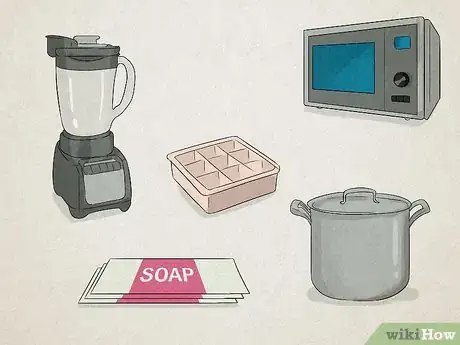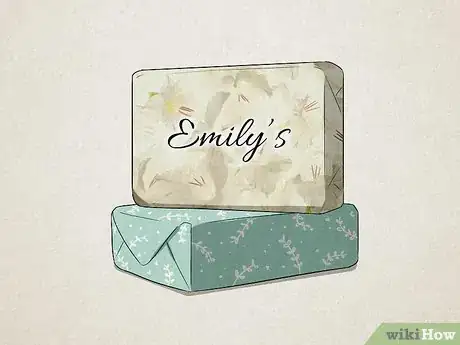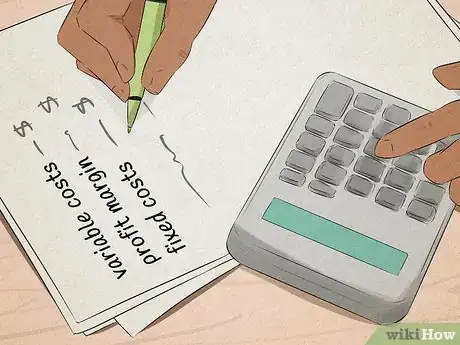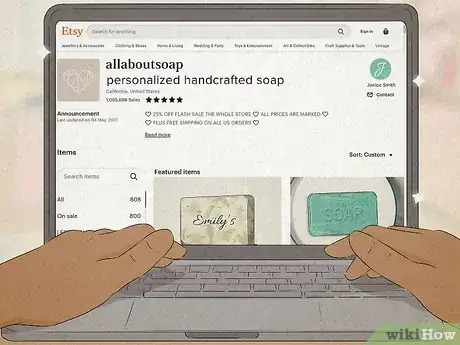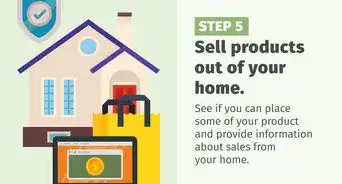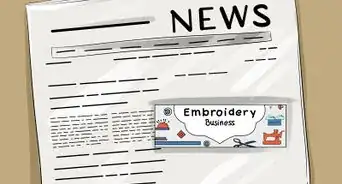This article was co-authored by wikiHow Staff. Our trained team of editors and researchers validate articles for accuracy and comprehensiveness. wikiHow's Content Management Team carefully monitors the work from our editorial staff to ensure that each article is backed by trusted research and meets our high quality standards.
There are 17 references cited in this article, which can be found at the bottom of the page.
wikiHow marks an article as reader-approved once it receives enough positive feedback. This article received 15 testimonials and 90% of readers who voted found it helpful, earning it our reader-approved status.
This article has been viewed 288,875 times.
Learn more...
Making soap is a fun hobby that can turn into a full-time business or at least a way to make a little extra money. Homemade soaps, especially those that use organic ingredients or beautiful designs, are a hit with many customers since they are an inexpensive luxury and a popular gift-giving idea. To succeed at the soap making business, you will need to develop quality soaps, control your inventory and pricing, and market your products.
Steps
Setting Up
-
1Learn how to make soap. Before you can succeed at selling soap, you must become an expert at making it, and refine the technique and formulae you want to use. There are two main methods for making soap, the hot process and the cold process.
- The cold process of making soap is the most common method. It involves mixing an alkali (usually lye) with fats or oils. Once mixed and formed into shape, it can take weeks for the soap to cure.
- The hot process of making soap requires you to cook the soap. This method requires no cure time, and can make it easier to add scents and colors. However, it is more difficult to work with and mold hot process soap.
- If you are new to soap making, consider taking a class in your area. Check with local crafts organizations, stores, and soap makers to see what opportunities are available.[1] [2]
-
2Develop a unique formula. Basic soap making only requires a few ingredients, but a wide variety of types of soap can be make by tweaking the formula.[3] If you want to create a product that stands out, experiment with ingredients like scents, colors, and moisturizers until you create a soap that you think is unique and high-quality.Advertisement
-
3Get the equipment you need. Soap making requires a few dedicated tools, and a space to work in (whether just your kitchen, or a full shop). As your soap making operation grows, you might purchase additional equipment, but to start out you will at least need:[4]
- A blender
- A microwave
- Molds
- A mixing kettle
- Labelers
- Wrappers
-
4Develop your brand. You’ll want to set yourself apart from the competition, and create a product that consumers really want. Think about who you want to buy your soaps, and what kind of niche your products will fill.[5] [6] For example, you might create soaps that are entirely free of any animal by-products for those consumers who care about animal rights, or soaps that are made using only all-natural ingredients for consumers who care about “green” and healthy living. Think about:
- Creating a unique and memorable company name[7]
- Using specially designed shapes
- Embossing the soap with letters or other forms
- Wrapping the soap in special papers or ribbons
- Creating a logo for your company
-
5Find suppliers. If you want to make soaps on a consistent scale, you will need a steady supply of oils, fats, scents, colors, wrappers, etc. You can go out and purchase all of these things yourself, but to save time and money you can order from suppliers that can ship the materials to you. Look for companies that can supply you with:
-
6Get professional assistance. When you are ready to get your business off the ground, it is a good idea to talk to an accountant, a tax advisor, and an attorney for assistance with the legal and financial aspects of starting a business.[13] While working with these professionals takes time and money, they can make the process easier, and help you avoid costly mistakes later on.
- Whether or not you are working with a professional accountant, learn how to use small business accounting software such as Quickbooks.[14] These programs can be a tremendous help in keeping up with inventory, sales, bills, and orders.
-
7Set up your business. To legally start a soap making business, you will have to formally incorporate a company. The exact requirements for doing so will vary depending on your location.
- The Small Business Administration can offer lots of assistance with setting up your business, including finding loans and investors, filling out required forms, getting insurance, meeting tax requirements, etc.[15]
- You should also contact your area’s local development board or small business administration about local support for setting up your business.
- If you are planning on hiring other employees, contact the IRS about getting an Employer Identification Number (EIN) for tax purposes.[16]
Succeeding
-
1Develop stock. You’ll want to have enough soap on hand to keep up with your orders. You don’t want to have orders coming in and no soap to supply, but on the other hand, you don’t want to invest money in making soaps that aren’t selling. When you are just starting out, it might pay to be a little conservative, but keep good track of your sales so that you can keep the proper inventory of soap around.
- Label and package your stock so that it is ready to ship or sell.
- Follow any labeling regulations in effect in your area. For example, the U.S. Food and Drug Administration (FDA) requires that you list all ingredients of a soap on its label.[17]
-
2Determine your pricing.[18] [19] The amount you want to sell your soap for will depend upon your market and product. For instance, you might price luxury soaps higher than those meant for everyday use. Research what competitors charge for soaps in your area, and set prices that are higher or lower, depending on your sales tactics.
- Consider offering specials, like sales around holidays, reduced rates on bulk orders, and offers like “buy 2, get 1 free.”
- Don’t set prices that are too low or too high. Try to set prices that will allow you to take care of your up-front costs (supplies, transportation, etc.), and hopefully leave a profit. If your sales increase, you can expect your profits to grow, but you don’t want to set prices so high at first that you don’t sell anything.
-
3Advertise. To be successful at selling soap, you need to understand your market, and how to reach it.[20] Spread the word about your soaps whenever and however you can, but target your primary market in particular. Common advertising possibilities include:
- Word-of-mouth
- Social media
- Advertisements online and in traditional media
- Business cards
- Sales displays
-
4Look for opportunities to sell in-person. Handmade crafts like soaps can be easily sold at various markets and other events. Don't be afraid to travel outside of your local area either, as this can increase your potential customer base. Opportunities may include:[21]
- Arts and crafts shows
- Farmers markets
- Home parties
-
5Sell your soap online. Many consumers shop and seek information online, even if they eventually buy products in person. If you want to succeed in the soap making business, be prepared to market your products online.[22] [23] This means not only making soaps available for sale via retailers like Etsy or your own website, but also promoting your product online through social media.
- If you sell online, you will need to consider shipping costs and how to handle them. Consider whether you will have customers pay for some or all of the shipping themselves, and whether or not you will offer a variety of shipping options (standard delivery, express, overnight, etc.).
-
6Sell in a brick-and-mortar store. You can approach existing stores about the possibility of selling yours soaps in them, or investigate opening your own physical store.[24] If you do decide to open your own store, you will have to look for a location, negotiate rent and insurance, decide on business hours, and make other considerations.
Community Q&A
-
QuestionWhat are the rules and regulations of a soap making business?
 Community AnswerThey vary depending on country, county, the variety of soap you are making, and how large your business will be. Check out your local governmental websites concerning sole proprietors (or otherwise), and regulations on exporting liquid soaps if that be your choice of business.
Community AnswerThey vary depending on country, county, the variety of soap you are making, and how large your business will be. Check out your local governmental websites concerning sole proprietors (or otherwise), and regulations on exporting liquid soaps if that be your choice of business. -
QuestionWhy do I need to put fats in my soap?
 Mzm555Top AnswererAdding fats, or "hard oils" (such as lard, coconut oil, palm oil, etc.) to a soap is necessary to give the soap the required "hardness" and long-lasting properties. Soap created without any fats tends to be too easily dissolved while you use them, and, additionally, have a tendency to turn soft and "mushy" when exposed to water for extended periods of time.
Mzm555Top AnswererAdding fats, or "hard oils" (such as lard, coconut oil, palm oil, etc.) to a soap is necessary to give the soap the required "hardness" and long-lasting properties. Soap created without any fats tends to be too easily dissolved while you use them, and, additionally, have a tendency to turn soft and "mushy" when exposed to water for extended periods of time. -
QuestionWhat is the fastest and shortest way to make soap? Have you got any way to make soap in one minute?
 Community AnswerThe fastest and shortest way to make soap is the melt-and-pour method. You can buy a soap base from a hobby store and you melt that down in the microwave (in the amount you want) and then set it in a mold. This will take more than a minute but it's fairly fast; the expectation of making soap in a minute is not realistic.
Community AnswerThe fastest and shortest way to make soap is the melt-and-pour method. You can buy a soap base from a hobby store and you melt that down in the microwave (in the amount you want) and then set it in a mold. This will take more than a minute but it's fairly fast; the expectation of making soap in a minute is not realistic.
References
- ↑ http://www.backporchsoap.com/index.php?main_page=index&cPath=34
- ↑ http://www.soapmakingstudio.com/classes.html
- ↑ http://www.smallstarter.com/browse-ideas/how-to-start-a-successful-soap-business-in-africa/
- ↑ http://www.soapequipment.com/
- ↑ http://www.entrepreneur.com/article/13372
- ↑ http://blog.worldlabel.com/2010/how-to-start-your-own-soap-business.html
- ↑ http://blog.worldlabel.com/2010/how-to-start-your-own-soap-business.html
- ↑ http://www.soaperschoice.com/
- ↑ http://www.bulknaturaloils.com/
- ↑ http://moldmarket.com/
- ↑ http://forcraftssake.com/shop/
- ↑ http://www.soapequipment.com/
- ↑ https://www.entrepreneur.com/article/81408
- ↑ http://blog.worldlabel.com/2010/how-to-start-your-own-soap-business.html
- ↑ https://www.sba.gov/
- ↑ https://www.irs.gov/Businesses/Small-Businesses-%26-Self-Employed/Apply-for-an-Employer-Identification-Number-%28EIN%29-Online
- ↑ http://blog.worldlabel.com/2010/how-to-start-your-own-soap-business.html
- ↑ http://blog.worldlabel.com/2010/how-to-start-your-own-soap-business.html
- ↑ https://www.economicsdiscussion.net/pricing/importance-of-pricing/31838
- ↑ http://blog.worldlabel.com/2010/how-to-start-your-own-soap-business.html
- ↑ http://blog.worldlabel.com/2010/how-to-start-your-own-soap-business.html
- ↑ http://blog.worldlabel.com/2010/how-to-start-your-own-soap-business.html
- ↑ http://smallbiztrends.com/2012/12/10-essentials-for-handmade-business-success.html
- ↑ http://blog.worldlabel.com/2010/how-to-start-your-own-soap-business.html
- ↑ http://www.soapguild.org/
- ↑ http://www.modernsoapmaking.com/
About This Article
If you want to start a soap making business, you will need a blender, a microwave, a mixing kettle, labelers, and wrappers. Plus, you’ll have to find long-term suppliers for your oils, molds, colors, and scents. Then, you should speak with an attorney and a tax advisor to make sure the business starts smoothly before you start building up stocks of soaps to sell. To learn how to determine pricing and advertise effectively, scroll down!


